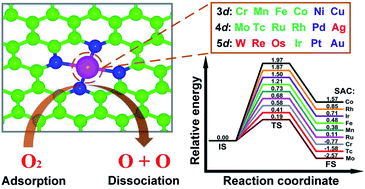Computational screening of efficient graphene-supported transition metal single atom catalysts toward the oxygen reduction reaction†
Abstract
Recent years have witnessed an explosive increase in the exploration of single atom catalysts (SACs) because of their high catalytic activity, selectivity, and maximal atom utilization. In this work, we systemically investigated the adsorption and dissociation of O2 molecules on a series of transition metals anchored on nitrogen-doped graphene as SACs by using density functional theory (DFT) calculations, aiming at screening highly efficient nanocatalysts toward the oxygen reduction reaction (ORR). Our calculations demonstrated that Ag, W, Re, and Os single atoms cannot be stably anchored on nitrogen-doped graphene. Furthermore, physical adsorption is observed between O2 molecules and Ni, Cu, Pd, Pt, and Au SACs, thus leading to catalytic inactivation. In contrast, O2 molecules can obtain more charges from Cr, Mn, Mo, and Tc SACs with the side-on absorption configuration than from the rest of the SACs with the end-on configuration, thus being beneficial to the dissociation of O2. By overall consideration of the reaction energy, energy barrier, and free energy, Mn SACs should be the optimal graphene-supported nonprecious metal SACs for the ORR. These results are helpful for comprehensive understanding of the interaction between O2 molecules and transition metal single atoms on graphene-based supports and provide new insights into design and application of cost-effective transition metal SACs.

- This article is part of the themed collection: Journal of Materials Chemistry A HOT Papers


 Please wait while we load your content...
Please wait while we load your content...